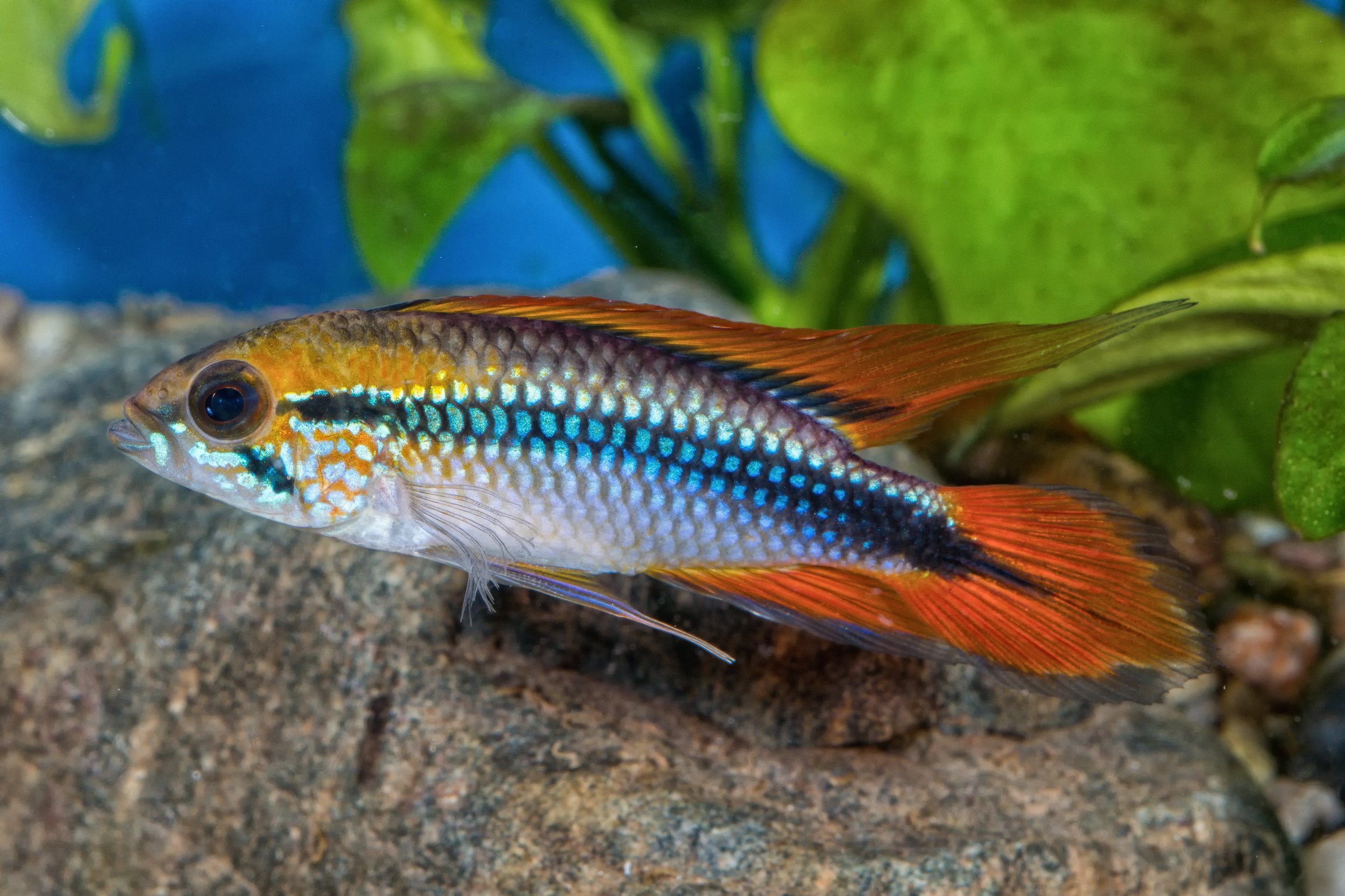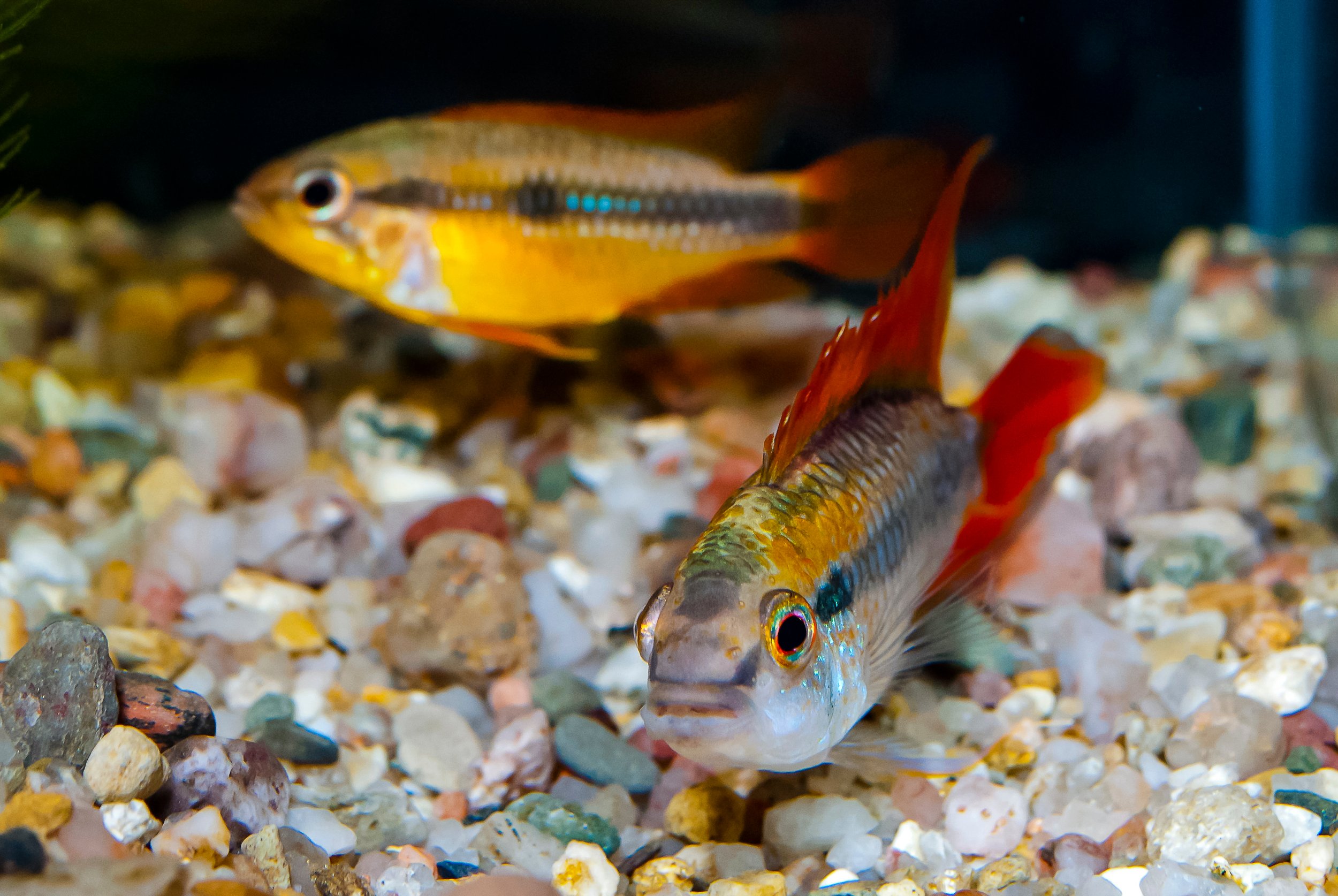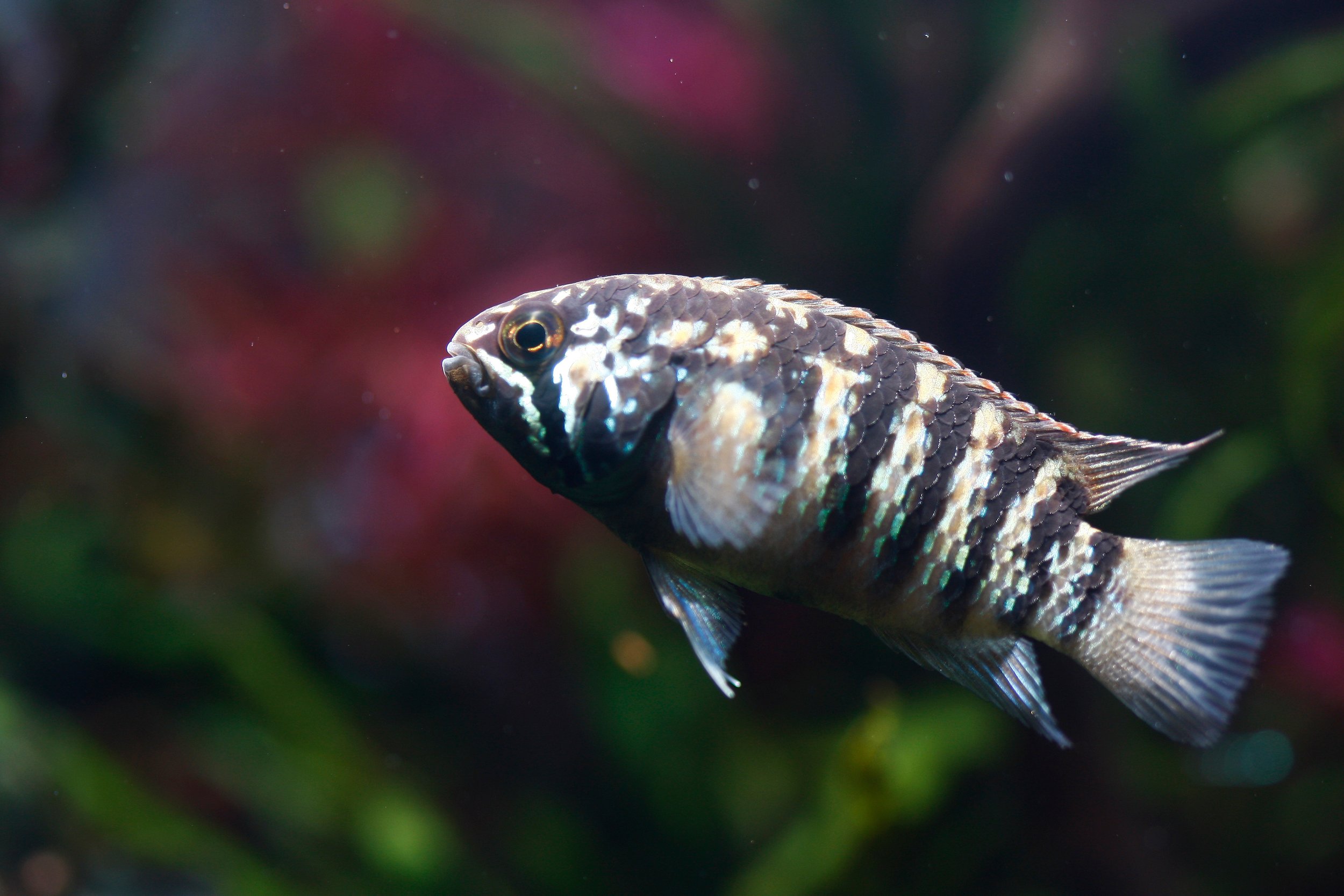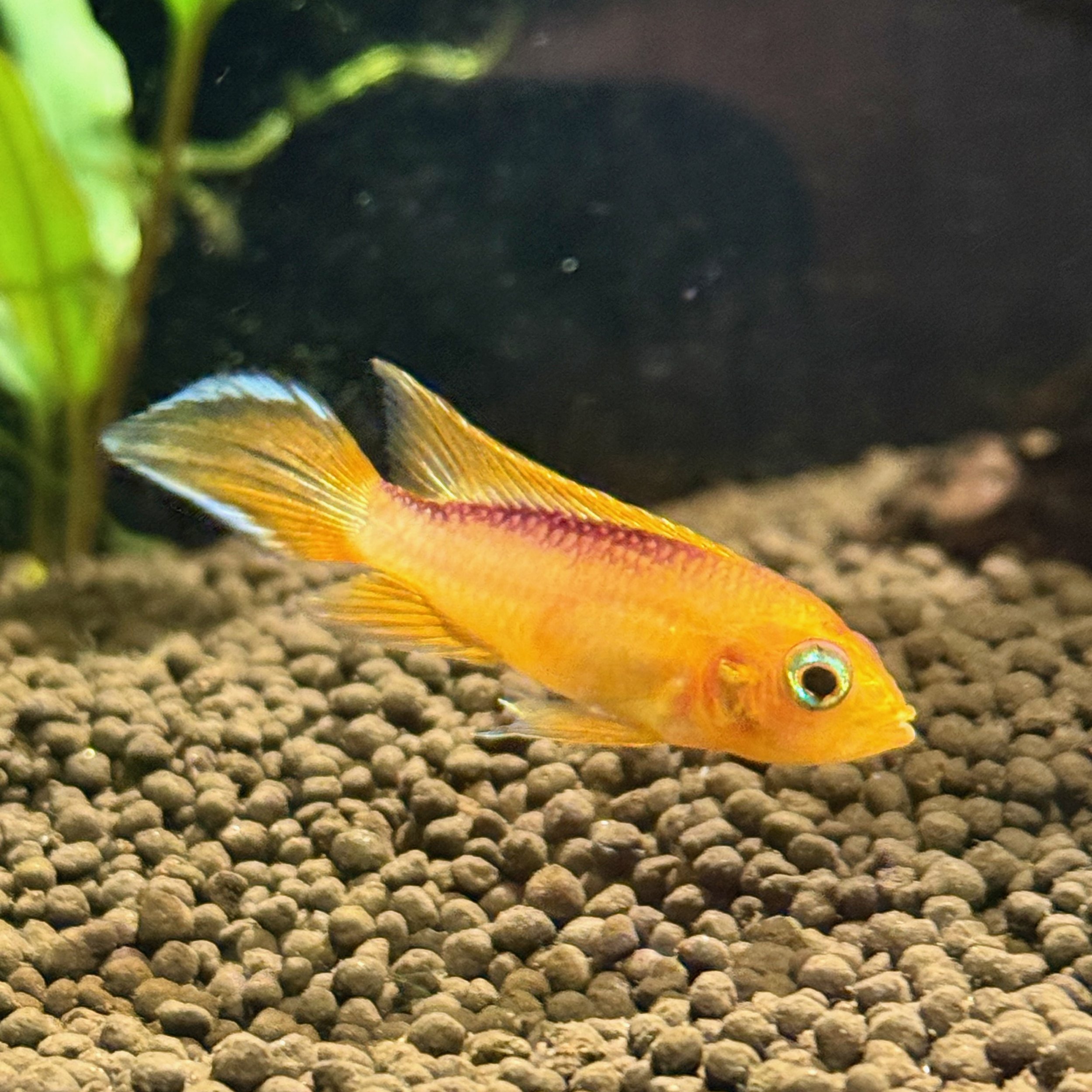 Image 1 of 2
Image 1 of 2

 Image 2 of 2
Image 2 of 2



Apistogramma Agassizii 'Double Red' UNSEXED
Apistogramma agassizii, commonly known as Agassiz's Dwarf Cichlid, is a stunning and highly sought-after species in the aquarium hobby. Known for its vibrant colors, fascinating behaviors, and manageable size, this South American dwarf cichlid originates from the slow-moving waters of the Amazon Basin, where it inhabits areas with dense vegetation and soft, acidic water. Its captivating appearance and relatively peaceful nature make it a favorite among aquarists, particularly those who enjoy keeping planted tanks or biotope setups.
Physically, Apistogramma agassizii is easily recognized by its elongated body, striking color patterns, and flowing fins, especially in males. Males typically exhibit a vibrant palette of colors, including electric blues, bright reds, and yellows, with iridescent highlights along the body and fins. The caudal fin is often spade-shaped and can display a gradient of bright hues. Females are generally smaller, with more subdued coloration, usually in shades of yellow and brown. Adult males can reach about 3 inches (7.5 centimeters), while females tend to be smaller, reaching around 2 inches (5 centimeters).
In the aquarium, Apistogramma agassizii thrives in environments that replicate its natural habitat. A well-planted tank with plenty of hiding spots, such as caves, driftwood, and dense vegetation, is essential for these cichlids to feel secure. They are bottom-dwellers and prefer a soft, sandy substrate where they can dig and explore. Despite their territorial tendencies, especially during breeding, they are generally peaceful and can be kept with other small, non-aggressive fish, such as tetras, rasboras, and Corydoras catfish. It's important to ensure that there are plenty of hiding places to reduce territorial aggression, especially if housing multiple males or pairs.
Water parameters for Apistogramma agassizii should mimic their natural environment. They prefer soft, slightly acidic water with a pH range of 5.0 to 7.0 and temperatures between 75 to 82°F (24 to 28°C). The use of tannins from Indian almond leaves or driftwood can help create more natural blackwater conditions, which these fish thrive in. Regular water changes and good filtration are essential to maintaining water quality, as Apistogramma species are sensitive to poor conditions.
Feeding Apistogramma agassizii is relatively simple, as they are omnivorous and will accept a variety of foods. They thrive on a diet of high-quality pellets or flakes, as well as live or frozen foods such as brine shrimp, bloodworms, and daphnia. Providing a varied diet rich in protein will help enhance their colors and overall health. Offering occasional vegetable matter, such as blanched spinach or spirulina-based foods, can also be beneficial.
Breeding Apistogramma agassizii in captivity is achievable and rewarding. These fish are cave spawners, with females typically laying their eggs inside small crevices or caves. After spawning, the female will fiercely guard the eggs and fry, while the male defends the territory from intruders. The eggs hatch in about 2 to 3 days, and the fry become free-swimming after 5 to 7 days. At this point, the fry can be fed on infusoria or specially prepared fry food, followed by baby brine shrimp as they grow. Providing multiple hiding places and caves in the aquarium will encourage natural breeding behaviors.
Overall, Apistogramma agassizii is a visually stunning and relatively easy-to-care-for dwarf cichlid that brings color, personality, and fascinating behavior to a well-maintained aquarium. With the right care and attention to their specific needs, these beautiful fish can thrive and even breed in captivity, offering aquarists the chance to observe their natural behaviors and enjoy their vibrant presence in the aquarium.
Apistogramma agassizii, commonly known as Agassiz's Dwarf Cichlid, is a stunning and highly sought-after species in the aquarium hobby. Known for its vibrant colors, fascinating behaviors, and manageable size, this South American dwarf cichlid originates from the slow-moving waters of the Amazon Basin, where it inhabits areas with dense vegetation and soft, acidic water. Its captivating appearance and relatively peaceful nature make it a favorite among aquarists, particularly those who enjoy keeping planted tanks or biotope setups.
Physically, Apistogramma agassizii is easily recognized by its elongated body, striking color patterns, and flowing fins, especially in males. Males typically exhibit a vibrant palette of colors, including electric blues, bright reds, and yellows, with iridescent highlights along the body and fins. The caudal fin is often spade-shaped and can display a gradient of bright hues. Females are generally smaller, with more subdued coloration, usually in shades of yellow and brown. Adult males can reach about 3 inches (7.5 centimeters), while females tend to be smaller, reaching around 2 inches (5 centimeters).
In the aquarium, Apistogramma agassizii thrives in environments that replicate its natural habitat. A well-planted tank with plenty of hiding spots, such as caves, driftwood, and dense vegetation, is essential for these cichlids to feel secure. They are bottom-dwellers and prefer a soft, sandy substrate where they can dig and explore. Despite their territorial tendencies, especially during breeding, they are generally peaceful and can be kept with other small, non-aggressive fish, such as tetras, rasboras, and Corydoras catfish. It's important to ensure that there are plenty of hiding places to reduce territorial aggression, especially if housing multiple males or pairs.
Water parameters for Apistogramma agassizii should mimic their natural environment. They prefer soft, slightly acidic water with a pH range of 5.0 to 7.0 and temperatures between 75 to 82°F (24 to 28°C). The use of tannins from Indian almond leaves or driftwood can help create more natural blackwater conditions, which these fish thrive in. Regular water changes and good filtration are essential to maintaining water quality, as Apistogramma species are sensitive to poor conditions.
Feeding Apistogramma agassizii is relatively simple, as they are omnivorous and will accept a variety of foods. They thrive on a diet of high-quality pellets or flakes, as well as live or frozen foods such as brine shrimp, bloodworms, and daphnia. Providing a varied diet rich in protein will help enhance their colors and overall health. Offering occasional vegetable matter, such as blanched spinach or spirulina-based foods, can also be beneficial.
Breeding Apistogramma agassizii in captivity is achievable and rewarding. These fish are cave spawners, with females typically laying their eggs inside small crevices or caves. After spawning, the female will fiercely guard the eggs and fry, while the male defends the territory from intruders. The eggs hatch in about 2 to 3 days, and the fry become free-swimming after 5 to 7 days. At this point, the fry can be fed on infusoria or specially prepared fry food, followed by baby brine shrimp as they grow. Providing multiple hiding places and caves in the aquarium will encourage natural breeding behaviors.
Overall, Apistogramma agassizii is a visually stunning and relatively easy-to-care-for dwarf cichlid that brings color, personality, and fascinating behavior to a well-maintained aquarium. With the right care and attention to their specific needs, these beautiful fish can thrive and even breed in captivity, offering aquarists the chance to observe their natural behaviors and enjoy their vibrant presence in the aquarium.
Apistogramma agassizii, commonly known as Agassiz's Dwarf Cichlid, is a stunning and highly sought-after species in the aquarium hobby. Known for its vibrant colors, fascinating behaviors, and manageable size, this South American dwarf cichlid originates from the slow-moving waters of the Amazon Basin, where it inhabits areas with dense vegetation and soft, acidic water. Its captivating appearance and relatively peaceful nature make it a favorite among aquarists, particularly those who enjoy keeping planted tanks or biotope setups.
Physically, Apistogramma agassizii is easily recognized by its elongated body, striking color patterns, and flowing fins, especially in males. Males typically exhibit a vibrant palette of colors, including electric blues, bright reds, and yellows, with iridescent highlights along the body and fins. The caudal fin is often spade-shaped and can display a gradient of bright hues. Females are generally smaller, with more subdued coloration, usually in shades of yellow and brown. Adult males can reach about 3 inches (7.5 centimeters), while females tend to be smaller, reaching around 2 inches (5 centimeters).
In the aquarium, Apistogramma agassizii thrives in environments that replicate its natural habitat. A well-planted tank with plenty of hiding spots, such as caves, driftwood, and dense vegetation, is essential for these cichlids to feel secure. They are bottom-dwellers and prefer a soft, sandy substrate where they can dig and explore. Despite their territorial tendencies, especially during breeding, they are generally peaceful and can be kept with other small, non-aggressive fish, such as tetras, rasboras, and Corydoras catfish. It's important to ensure that there are plenty of hiding places to reduce territorial aggression, especially if housing multiple males or pairs.
Water parameters for Apistogramma agassizii should mimic their natural environment. They prefer soft, slightly acidic water with a pH range of 5.0 to 7.0 and temperatures between 75 to 82°F (24 to 28°C). The use of tannins from Indian almond leaves or driftwood can help create more natural blackwater conditions, which these fish thrive in. Regular water changes and good filtration are essential to maintaining water quality, as Apistogramma species are sensitive to poor conditions.
Feeding Apistogramma agassizii is relatively simple, as they are omnivorous and will accept a variety of foods. They thrive on a diet of high-quality pellets or flakes, as well as live or frozen foods such as brine shrimp, bloodworms, and daphnia. Providing a varied diet rich in protein will help enhance their colors and overall health. Offering occasional vegetable matter, such as blanched spinach or spirulina-based foods, can also be beneficial.
Breeding Apistogramma agassizii in captivity is achievable and rewarding. These fish are cave spawners, with females typically laying their eggs inside small crevices or caves. After spawning, the female will fiercely guard the eggs and fry, while the male defends the territory from intruders. The eggs hatch in about 2 to 3 days, and the fry become free-swimming after 5 to 7 days. At this point, the fry can be fed on infusoria or specially prepared fry food, followed by baby brine shrimp as they grow. Providing multiple hiding places and caves in the aquarium will encourage natural breeding behaviors.
Overall, Apistogramma agassizii is a visually stunning and relatively easy-to-care-for dwarf cichlid that brings color, personality, and fascinating behavior to a well-maintained aquarium. With the right care and attention to their specific needs, these beautiful fish can thrive and even breed in captivity, offering aquarists the chance to observe their natural behaviors and enjoy their vibrant presence in the aquarium.






